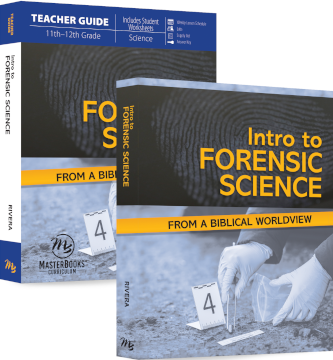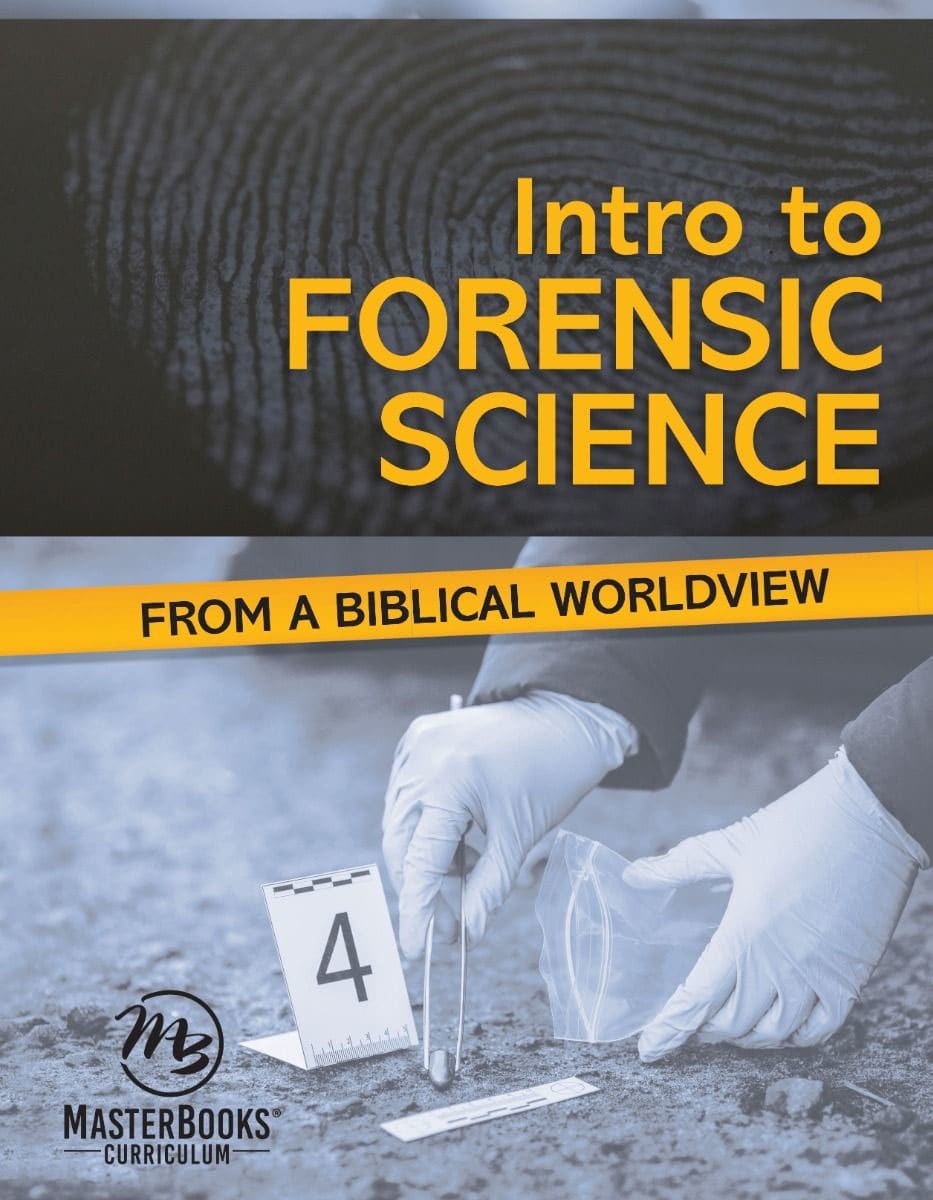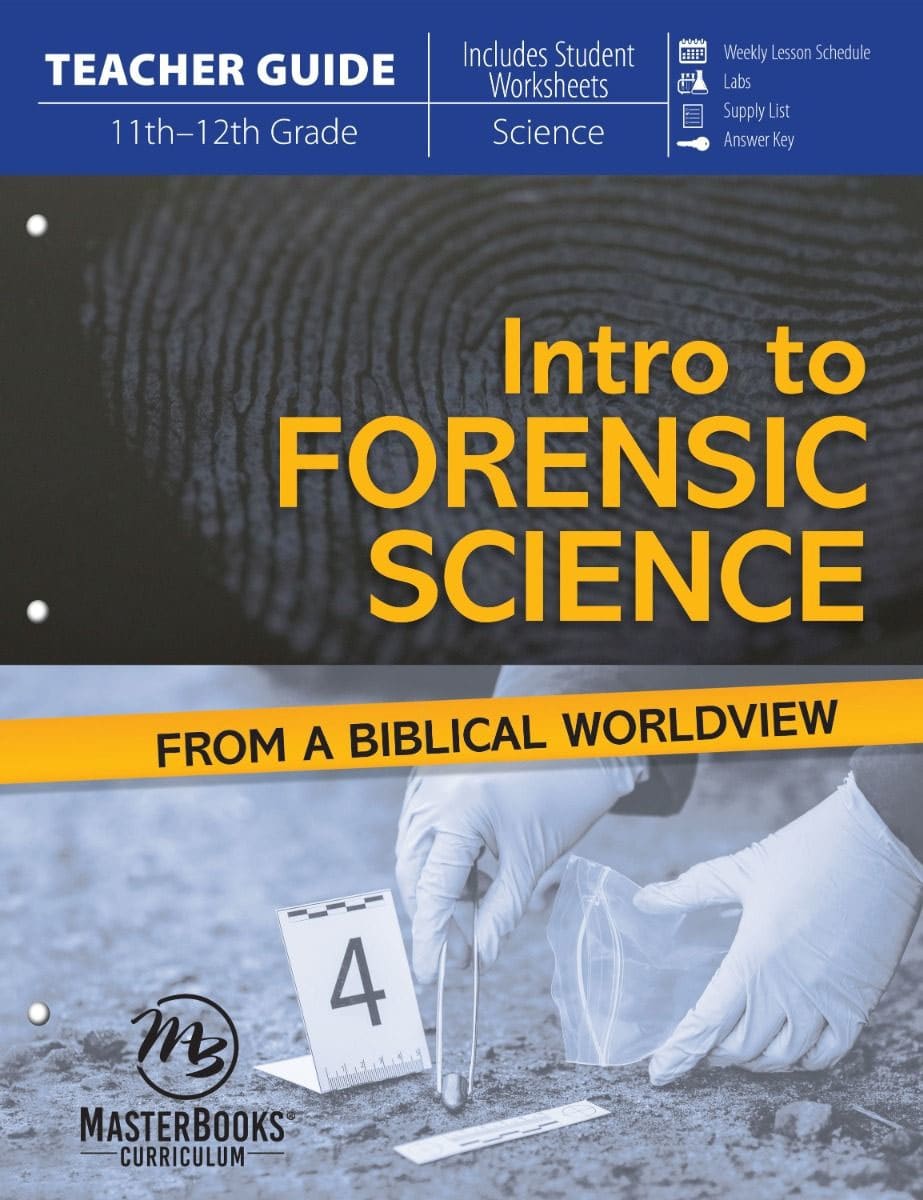Intro to Forensic Science from a Biblical Worldview is a two-semester lab science course, recommended for grades 11 and 12. The course consists of a 450-page student textbook and a Teacher Guide, both printed in full color.
The course has 34 lessons divided into eight units titled Introduction, The Crime Scene, Physical Evidence, Biological Evidence, Transitory Evidence, Forensic Tools, Forensic Specialties, and The Judicial System. The course delves into several scientific disciplines and teaches about the processes of collecting, conveying, and analyzing evidence for the purposes of our legal system.
Each lesson is broken down into five parts to be completed in about 45 minutes per day. On the first four days of the week, students read from the student textbook and complete worksheets from the Teacher Guide. On the fifth day, they have an application worksheet and a lab activity. The worksheet questions are a mixture of multiple-choice, fill-in-the-blank, short answer, matching, labeling, and chart completion. Most answers are predictable, and the answer keys include key points students should include in the short-written responses. The lab activities might be hands-on, an analysis of provided information, or a combination of both. The textbook reading always includes a biblical worldview component that relates the lesson topic to a biblical principle or event.
The first two lessons (that make up the Introduction unit), teach about the nature of forensic science and the two types of science, historical and observational. The discussion of historical science makes the point that this is often the approach of forensic scientists as they try to reconstruct a one-time event that can never be repeated or observed. While most science courses emphasize the observational scientific method, the historical method is used by paleontology, archaeology, and other branches of science, as it is in forensic science. This has particular application to the origins debate, since Charles Darwin employed the historical method, as do modern-day evolutionists and creation scientists. Observational science often contributes knowledge that applies to historical science, but it isn’t the only valid approach to science.
Each chapter begins with a real-life case study, sometimes based on famous people and events such as O.J. Simpson’s murder trial, the death of Michael Jackson, and the Oklahoma City Bombing. Topics addressed within these case studies, as well as in some lesson material, make the course most suitable for older teens. For instance, Lesson 5: Drugs, begins with the Case Study: Death of Michael Jackson, which was due to the misuse of drugs. The lesson goes into extensive detail about various types of drugs and how drug evidence is collected and tested, while also addressing drug abuse and problems of drug addiction. Other lessons inevitably mention murder, sexual immorality, and other factors considered by forensic scientists. This is one reason the course overview advises the teacher to discuss the case studies with students and address difficult information.
Teacher Guide
The Teacher Guide begins with 13 pages for the teacher and ends with more than 50 pages of answer keys, but the bulk of this 550-page book consists of student pages for vocabulary, worksheets with questions, and lab activities. You are permitted to copy or print student pages from the Teacher Guide for family members, so you might prefer to buy the PDF version of the Teacher Guide rather than the printed book. On the other hand, the printed Teacher Guide is a large, paperback book, punched with three holes so pages can be removed and kept in a student’s binder—great if you will use the course with only one student.
While the Teacher Guide is printed in full color, most pages can be printed in black and white. However, the color is critical on a few pages, so you either need to print those in color or give students access to the PDF or printed book.
Vocabulary terms are introduced on the first page for each lesson in the Teacher Guide and are also included in a glossary near the end of the student textbook. The vocabulary page from the Teacher Guide should be printed or copied for students.
A parent or teacher should supervise the labs and discuss case studies, but I think students are likely to work through most of the course on their own. The Teacher Guide does not include the textbook pages, so a parent needs to borrow the student textbook to read the case studies and lesson content. It seems unlikely that most parents will try to read the entire textbook under those circumstances. However, some parents might find the course so interesting that they will manage to read the textbook.
Labs
A Master Supply List near the beginning of the Teacher Guide lists supplies for the labs under categories: Kitchen Supplies, Food Items, Household Supplies, Craft Supplies, Tools/Outdoor Supplies, Lab Supplies, and Miscellaneous Items. Pages 462 to 464 provide another list of supplies that is arranged differently. It begins with a short list of frequently used supplies, such as a metric ruler, a scientific calculator, and forceps. Then it lists the additional supplies required for each lab activity. The frequently used supplies list a microscope, a magnifying glass, or a magnifier app, so a microscope is optional. (I believe that students benefit most if they have a device or tool that provides higher magnification than is available with a magnifying glass, but a magnifying glass will suffice.) Most resources are easy to obtain, but a few might not be. The most challenging items I spotted were fingerprint black powder or magnetic powder, iodine, glycerin, pH strips, test tubes, Petri dishes, and three animal fur samples (easily available if you have access to three cats or dogs). Alternatives are given for some items, such as substituting ground pencil lead or eyeshadow for fingerprint powder.
To make things easier, Master Books sells a kit with all the supplies you need for this course aside from a few household items and a scientific calculator. The kit is available with or without a microscope, but if you forego the microscope, the kit still has a magnifying glass that will suffice for magnified viewing. Also in the kit are supplies like foam trays, pipe cleaners, and colored pencils as well as lab equipment, such as a graduated cylinder, beakers, microscope slides, and Petri dishes. It even has the fur samples.
Overall, the labs are very manageable in a homeschool setting. It should be easy for students to follow the lab instructions on their own.
Online Course
Master Books has created the Intro to Forensic Science online course that uses the Intro to Forensic Science textbook and Teacher Guide. Video instruction enhances the textbook and provides multisensory input. The online course includes automatically graded exercises and tests. It also provides lab demonstrations that support student lab work done at home; lab demonstrations do not replace student lab work. Students still need the application and lab pages found in the Teacher Guide.
Summary
Intro to Forensic Science is the first course on this topic that I know of for high school students, and it has to be the only one written from a biblical worldview. Beyond its uniqueness, this course offers teens a lab science course far different than the standard courses. It’s not as rigorous as many other high school lab science courses, but it might be more inspiring with its links to real life (as well as movies and TV) and its many practical applications.












